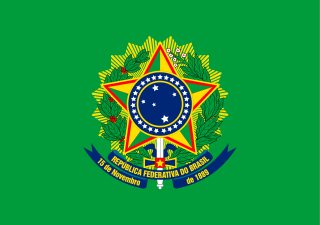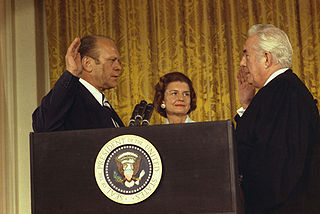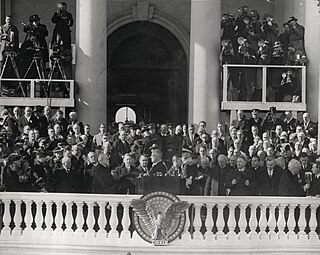Related Research Articles

The Twentieth Amendment to the United States Constitution moved the beginning and ending of the terms of the president and vice president from March 4 to January 20, and of members of Congress from March 4 to January 3. It also has provisions that determine what is to be done when there is no president-elect. The Twentieth Amendment was adopted on January 23, 1933.

The vice president of the United States (VPOTUS) is the second-highest officer in the executive branch of the U.S. federal government, after the president of the United States, and ranks first in the presidential line of succession. The vice president is also an officer in the legislative branch, as the president of the Senate. In this capacity, the vice president is empowered to preside over the United States Senate, but may not vote except to cast a tie-breaking vote. The vice president is indirectly elected together with the president to a four-year term of office by the people of the United States through the Electoral College. Since the passage of the Twenty-fifth Amendment to the US Constitution, the vice president may also be appointed by the president to fill a vacancy, via majority confirmation by both the Senate and the House.

The Twenty-second Amendment to the United States Constitution limits the number of times a person can be elected to the office of President of the United States to two terms, and sets additional eligibility conditions for presidents who succeed to the unexpired terms of their predecessors. Congress approved the Twenty-second Amendment on March 21, 1947, and submitted it to the state legislatures for ratification. That process was completed on February 27, 1951, when the requisite 36 of the 48 states had ratified the amendment, and its provisions came into force on that date.

The United States presidential line of succession is the order in which the vice president of the United States and other officers of the United States federal government assume the powers and duties of the U.S. presidency upon an elected president's death, resignation, removal from office, or incapacity.
An acting president of the United States is an individual who legitimately exercises the powers and duties of the president of the United States even though that person does not hold the office in their own right. There is an established presidential line of succession in which officials of the United States federal government may be called upon to take on presidential responsibilities if the incumbent president becomes incapacitated, dies, resigns, is removed from office during their four-year term of office; or if a president-elect has not been chosen before Inauguration Day or has failed to qualify by that date.

The president of Brazil, officially the president of the Federative Republic of Brazil or simply the President of the Republic, is the head of state and head of government of Brazil. The president leads the executive branch of the federal government and is the commander-in-chief of the Brazilian Armed Forces.

The oath of office of the president of the United States is the oath or affirmation that the president of the United States takes upon assuming office. The wording of the oath is specified in Article II, Section One, Clause 8, of the United States Constitution, and a new president must take it before exercising or carrying out any official powers or duties.

Between 73 and 79 days after the presidential election, the president-elect of the United States is inaugurated as president by taking the presidential oath of office. The inauguration takes place for each new presidential term, even if the president is continuing in office for a second term.

The vice president of the Republic of Liberia is the second-highest executive official in Liberia, and one of only two elected executive offices along with the president. The vice president is elected on the same ticket with the president to a six-year term. In the event of the death, resignation or removal of the president, the vice president ascends to the presidency, and holds the position for the remainder of their predecessor's term. The vice president also serves as the president of the Senate and may cast a vote in the event of a tie. The current vice president is Jeremiah Koung, serving under president Joseph Boakai. He began his term on January 22, 2024.

Party divisions of United States Congresses have played a central role on the organization and operations of both chambers of the United States Congress—the Senate and the House of Representatives—since its establishment as the bicameral legislature of the Federal government of the United States in 1789. Political parties had not been anticipated when the U.S. Constitution was drafted in 1787, nor did they exist at the time the first Senate elections and House elections occurred in 1788 and 1789. Organized political parties developed in the U.S. in the 1790s, but political factions—from which organized parties evolved—began to appear almost immediately after the 1st Congress convened. Those who supported the Washington administration were referred to as "pro-administration" and would eventually form the Federalist Party, while those in opposition joined the emerging Democratic-Republican Party.
The president-elect of the United States is the candidate who has presumptively won the United States presidential election and is awaiting inauguration to become the president. There is no explicit indication in the U.S. Constitution as to when that person actually becomes president-elect, although the Twentieth Amendment uses the term "president-elect", thus giving the term "president-elect" constitutional justification. It is assumed the Congressional certification of votes cast by the Electoral College of the United States – occurring after the third day of January following the swearing-in of the new Congress, per provisions of the Twelfth Amendment – unambiguously confirms the successful candidate as the official "president-elect" under the U.S. Constitution. As an unofficial term, president-elect has been used by the media since at least the latter half of the 19th century, and was in use by politicians since at least the 1790s. Politicians and the media have applied the term to the projected winner, even on election night, and very few who turned out to have lost have been referred to as such.

The inauguration of Gerald Ford as the 38th president of the United States was held on Friday, August 9, 1974, in the East Room of the White House in Washington, D.C., after President Richard Nixon resigned due to the Watergate scandal. The inauguration – the last non-scheduled, extraordinary inauguration to take place in the 20th century – marked the commencement of Gerald Ford's only term as president. Chief Justice Warren E. Burger administered the oath of office. The Bible upon which Ford recited the oath was held by his wife, Betty Ford, open to Proverbs 3:5–6. Ford was the ninth vice president to succeed to the presidency intra-term, and he remains the most recent to do so, as of 2024.

The third inauguration of Franklin D. Roosevelt as president of the United States was held on Monday, January 20, 1941, at the East Portico of the United States Capitol in Washington, D.C. This was the 39th inauguration and marked the commencement of the third, and eventually final full term of Franklin D. Roosevelt as president and the only term of Henry A. Wallace as vice president. This was the first and only time a president has been inaugurated for a third term; after the Twenty-second Amendment to the United States Constitution was ratified in 1951, no person can be elected president more than twice, though three terms are still allowed provided at least one partial term of 2 years or less.
The second inauguration of Franklin D. Roosevelt as president of the United States was held on Wednesday, January 20, 1937, at the East Portico of the United States Capitol in Washington, D.C. This was the 38th presidential inauguration and marked the commencement of the second term of Franklin D. Roosevelt as president and John Nance Garner as vice president. It was the first inauguration to take place on January 20 per the 20th Amendment to the U.S. Constitution. This was also the first time the vice president took the oath of office on the inaugural platform rather than in the Senate Chamber. The length of Roosevelt's term as president, and Garner's as vice president had already been shortened by 43 days.